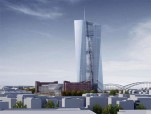Headquarters for ECB

In Frankfurt am Main is almost completed construction works on the new headquarters of the European Central Bank (ECB), designed by the Austrian architectural office COOP HIMMELB(L)AU. This March, it reached the planned height, and commissioning is scheduled in 2014. The design of the Vienna-based architects comprises three architecturally intertwined elements: i) the former Grossmarkthalle, which is to be retained, ii) the double office tower, and iii) a new entrance building, connecting these two elements. The buildings complex also includes an underground car park and ancillary buildings accommodating the gatehouses and logistics centre. Recently the architectural office of COOP HIMMELB(L)AU has won a prestigious award Hessian Culture Prize for this project. The prize of € 45,000 is awarded annually since 1982 in accordance with the decision of the Cabinet of Ministers of the Government of Hessen for outstanding achievements in the arts, science and culture.
InArchitectural concept
The ECB is a relatively young European institution, having been founded only in 1998. In the same year, following a recommendation by the European Court of Auditors to all European institutions that it is much more costeffective in the long term to own premises than to rent, it launched an extensive search for a suitable site on which to build its own offices. The ECB was looking for this plot since 1998, but defined and gained the site in the district of Ostend, on the banks of the Main River, only in March 2002.
At a height of around 185 meters, the double tower, with its polygonal shape and east-west orientation, has a striking profile that is visible from all important reference points in Frankfurt’s city center, as well as from the river Main. The location for the new headquarters of the European Central Bank (ECB) in Frankfurt’s Ostend district has the potential of adding a new landmark to the Frankfurt skyline that will be visible at great distances. The tower ensemble is the result of a design process inspired by the urban links with the city of Frankfurt. Owing to its clear orientation towards the important urban perspectives, the ensemble enters into a dialogue with the important urban reference points in Frankfurt: the Alte Oper, the Museumsufer and the financial district. Thanks to its form and presence, the double tower will become a characteristic feature of the Frankfurt skyline.
Full content of this issue you can read here
The full version of the article can be read in our printed issue, also you can subscribe to the web-version of the magazine
 Materials provided by COOP HIMMELB(L)AU
Materials provided by COOP HIMMELB(L)AU


